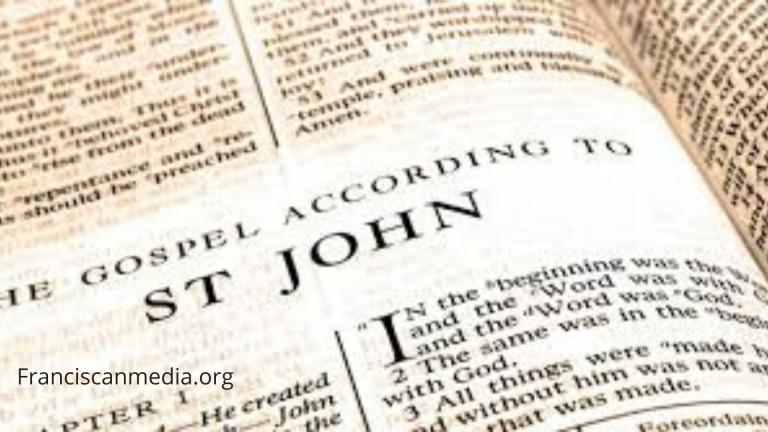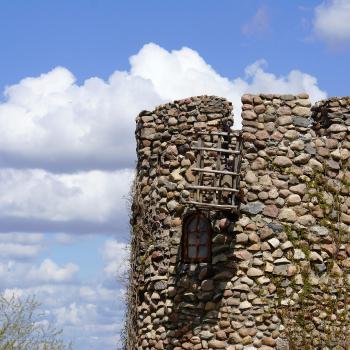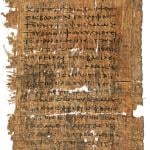
Monday: Read John 4:27-54
In this section, John stresses Jesus as the Word. Jesus speaks and things happen. John also notes that it is the Samaritans and not the Galileans who believe His word.
The disciples return from getting the food (27; cf 4:8) and see that Jesus was speaking with a woman. They must have been amazed to see that Jesus was speaking with a Samaritan, let alone a woman, though no one dared to ask Him.
The woman leaves everything behind and rushes into the city and began asking if this was the Christ (29). Just like Philip had told Nathaniel about Jesus and urged him, “come and see” (1:46), so now the Samaritan woman brings many from her city to Jesus. John notes that the Samaritans “believed because of His word” (41-42). This will serve as a contrast to others who believe only because of His signs!
Jesus then appears in Cana. The earlier account in Cana (2:1-12) and this latter account (4:46-54) form an inclusio (a frame) for this section 2:1-4:54. This is confirmed by the fact that John refers back to the turning water into wine (46), which was Jesus’ first “sign” (2:11). And he refers to the healing of the official’s son as the “second sign” (54).
Those in Cana (in Galilee), however, were not as receptive as those in Samaria. After all, as John reminds us, a prophet is not welcome in His home country (4:44).
Jesus does heal the official’s son. John notes that Jesus heals the son from a distance and by means of His spoken word (50). The father, like the Samaritans, “believed the word that Jesus spoke” (50).
Questions to ponder/discuss:
- The question of believing God/Jesus’ word goes back to the Garden of Eden. Adam and Eve failed to believe what God had spoken and instead listened to the serpent. What are some reasons that hinder you from “believing the Word that Jesus spoke”? (One reason we come up with for not believing His word is that “He never speaks to me.” To which I would respond, “we have 66 books of His word written to you”).
- Read Psalm 1:1-3: meditate on the Word day and night!
- Note Proverbs 1:7: this is a good verse to summarize the message of John!
Tuesday: Read John 5:1-47
In John 5-10, John depicts Jesus as the fulfillment of major Jewish festivals. John will mention a festival (Sabbath, Passover, Tabernacles) and then show that Jesus either fulfills its primary symbols or that He has authority over the festival itself.
Jesus returns to Jerusalem for “the feast” (1). Jews were required to travel to Jerusalem for three different feasts (Passover, Pentecost, and Tabernacles—though most made it to only one of the three). So, we presume that it is one of these three feasts that Jesus is in town for.
NB: If this feast is the Passover, then we may conclude that Jesus’ ministry lasted 3½ years—since it would have spanned 4 Passovers (cf 2:13; 6:4; 13:1).
In this chapter (5:1-47), the Sabbath (which is technically a weekly festival) is fulfilled in Jesus. The chapter is set up almost as a trial scene of sorts.[2] Jesus’ miracle of healing a paralytic serves as the evidence. The problem is that Jesus healed the paralytic on the Sabbath (9).
The issue of what was permitted on the Sabbath comes from various Jewish expectations and interpretations of the Law. The Jewish authorities had discerned 39 categories of sabbath violations.
NB: we tend to scorn the Pharisees for their “legalism.” This is not a helpful way of reading the NT. They believed it was their obligation to help the people know how to apply the laws in their present context. Jesus’ conflict with them centered around the fact that they were more concerned about maintaining their status in society and the privileges that came with it, than they were with helping the people.
In these 39 provisions, healing was only permitted if it were necessary to save a life. That the man Jesus heals had been an invalid for 38 years suggests that He could have waited another day! Jesus again heals by His spoken word (8).
Jesus answers their complaints (17) (even though no questions were mentioned), by saying, “I’m only doing what my Father does!” (17, 19).
The Jews believed that God continues to work on the Sabbath. After all, He sustains creation (Heb 1:3) and gives life on the Sabbath—babies are born on the Sabbath! Since God works on the Sabbath and is not violating it, Jesus reasons, neither am I! After all, Jesus argues, the son is to learn the trade of his father. The Jewish authorities recognize Jesus’ words as blasphemous, because “He was calling God His own Father, making Himself equal with God” (18).
Jesus adds, that even though His own testimony is valid in and of itself (31), He has other witnesses. There is the witness of John the Baptist (33-35). Jesus’ own works testify who He is (36). The Father also testifies (37-38). And Moses testifies (46).
Questions to ponder/discuss:
- Again, we are left with the question of whether or not we are willing to believe what Jesus has spoken? For instance, Jesus commands us to love our neighbors so much that we are willing to lay down our lives for them. Do we believe these words so that we are willing to do what He says? Or are we too more concerned with maintaining our status?
Wednesday: Read John 6:1-40
In 6:1-71, John portrays Jesus as the fulfillment of the Jewish feast of Passover by noting that Jesus is the bread of life.
In John 4, Jesus offers the woman at the well the gift of water that would become “a well of water springing up to eternal life” (4:14). Now, Jesus offers the gift of bread that also gives “eternal life” (27). Note that the living water (4:10) is the Holy Spirit (7:37-39) and is given by Jesus (4:10). And the Bread of life is Jesus (6:35), and the giver is the Father (32).
The miracle of the feeding of the 5,000 (6:1-14) is the only miracle listed in all four Gospels. For John, it is important because Jesus uses this occasion to announce that He is the Bread of Life.
That the Bread Jesus gives “comes down out of heaven” (38) reminds the readers of the manna that Moses fed the Israelites; which also came down from heaven (33; Ps 78:24). Note that Moses’ two miracles were the provision of bread/manna and the passing through the sea.[3] Thus, John follows the story of Jesus’ multiplying bread with Jesus’ walking on the water! Jesus is greater than Moses!
Questions to ponder/discuss:
- Jesus’ exhortation “Do not work for the food which perishes, but for the food which endures to eternal life” (27) sounds a lot like Luke’s teaching on the kingdom. The difference is that John substitutes “eternal life” for “kingdom.” For both John and Luke, the command is that we should work towards what is eternal.
- This, of course, opens up a rabbit hole of questions pertaining to “what is eternal?” To address this briefly, we might note that love is eternal (1 Cor 13:8). Based on the resurrection of Jesus, we would also note that there is a physicality to eternity. In other words, that which is eternal is more than just the “soul” and “heaven.” Perhaps the best way to phrase it is that the things pertaining to the kingdom of God last forever (justice, love, kindness, persons, creation, etc), and the things pertaining to the kingdoms of the world (hate, power through violence, injustice, death, etc) do not last forever. Make it your prayer and effort to “seek first His kingdom” (Matt 6:33).
Thursday: Read John 6:41-71
John 6:41 is quite explicit: Jesus declares Himself to be the Bread of Life (33; think of the manna that Moses provided). John notes that the “Jews were grumbling” (41). This is exactly what the Israelites were doing (“grumbling”) in the account of the manna from heaven (Exod 16:1; Num 14).
Jesus replies that they cannot believe in Him unless they are drawn by the Father (44). The result is that those who are drawn to Him will be “taught of God” (45). And they will believe and gain eternal life (47).
Jesus again affirms that He is the Bread of Life (48). He is the living bread that came down out of heaven (51). To eat of this bread—that is, Christ—is to partake of eternal life (51). This sounds just like the promise in the Garden related to the Tree of Life. If Adam and Eve were to eat from that tree they would live forever (Gen 3:22). Of course, this doesn’t make sense to those listening to Jesus (it baffles many today as well). To make matters worse, Jesus adds, “and drink His blood” (53) to the equation.
This leads “many of His disciples” to grumble (60-61). It is important here to recognize that when John says “disciples” he has in mind a wider group of people who were following Jesus. Well, they were following Jesus until now! John notes, “As a result of this many of His disciples withdrew and were not walking with Him anymore” (66).
Jesus then asks the “12” if they want to leave. Peter replies, “Lord, to whom shall we go? You have words of eternal life” (68).
Questions to ponder/discuss:
- Too often passages like this are dealt with in a sort of either/or frame of mind. It is suggested that either Jesus was talking about literally eating and drinking His body/blood, or He was talking about metaphorically eating and drinking His body. This sort of either/or approach is actually the product of modern enlightenment thinking and does not reflect well what Jesus would have meant.
- We know that when Jesus says that we must eat and drink Him that He was talking about “believing in Him” (see John’s note in 6:64). But could it be that Jesus means by believing in Him that we also literally look to Him as our source of bread and water—maybe not in a cannibalistic way, but in the sense that we find our nourishment in Him and the Spirit? This is more than just “believing” it is “believing and partaking.” If you have access to a body of believers in which you are able to take communion, I encourage you to do so and to recognize that you are both “believing and partaking” of Christ. (when we get to 1 Corinthians, we will add another element to our understanding of communion).
Friday: Read John 7:1-39
The events of John 7-8 take place during the Feast of Tabernacles or Booths (2). Once again, John portrays Jesus as the fulfillment of this feast! In order to understand what John describes in these chapters, we need to reflect a bit on the Feast of Tabernacles.
The Feast of Tabernacles occurs every year in the Fall. It commemorates the Israelites’ Exodus from Egyptian slavery, as well as their 40 years of wandering in the wilderness: during which time they lived in tents (hence, the Feast of Tabernacles/Booths). The Feast was also associated with the ingathering of the Fall harvest (grapes and olives—tree and vine). Most significantly it was connected with the formation of the nation of Israel—thus it was a very political event taking place in the midst of the Roman world. During the time of the NT, the Feast also looked forward to a new Exodus when they would be set free from Roman oppression and a renewed Israel would be established.
The Feast of Tabernacles was one of the 3 major feasts in Israel for which the Israelites were required to attend (most attended only one of the 3: Tabernacles, Passover, and Pentecost). Tabernacles may have been the most popular of the feasts because it was associated with joy. Tabernacles lasted seven days with a special festival assembly on the 8th day.
During the Feast of Tabernacles, there was much dancing in the courtyards of the Temple, and massive lights and torches were lit that illuminated much of Jerusalem each night (this was a significant thing in the ancient world). Each day there was a processional led by the High Priest that began with the drawing of water from the pool of Siloam and carried to the Temple. During the processional, the people sang the Hallel Psalms (113-118). This singing climaxed with the singing of “O Lord, save us; O Lord, grant us success” (Ps 118:25).
Jesus encounters the Jewish authorities in dialogue. Again, He asserts that He was sent by the Father (16). They were still angry with Jesus because He healed a man on the Sabbath (5:1-17).
Some begin to wonder if Jesus might be the Christ/Messiah (26). But they discount it because they, “know where Jesus is from”; but, they reasoned, no one knows where the Messiah comes from (27).
This is one of many instances of John’s use of irony. John expects his readers to see the irony of the fact that the people conclude that Jesus cannot be the Messiah because they “know where He is from,” but we (the readers) know that Jesus is from God and that they don’t know this (29).
Questions to ponder/discuss:
- The story of the coming of Jesus, sent from God, in the Gospel of John reminds us of a key question: “would we have been like the Jewish authorities and rejected Jesus because He didn’t match what we were expecting, or what we were wanting”?
- John is clear: one of the reasons they rejected Jesus is because they were seeking their own glory—which, he says, came from one another (5:41-44). In other words, we have been asking if we are willing to believe that Jesus really is the source of life? —and by “believe” we mean a wholesale belief that transforms our very being. Or do we “believe” just enough so that we can go to heaven, but not enough to where it actually makes a difference in how we live and love? For John, there is a huge difference. One form of belief gives life, and the other does not.
our goal is to keep these posts free of charge. I do not intend to ever hide them behind a paywall. I can only do this if those of you who have been blessed by them and can afford to give ($5, $10, $25, or more/month) do so. You can give a tax-deductible contribution by following this link.
Please share this post and let others know about determinetruth.
If you wish to view this blog on your smartphone through the Determinetruth app simply download the “tithe.ly church” app on your smartphone and insert “determinetruth” as the church name you wish to follow. Once it is loaded, simply click on the “blog” icon and it will automatically load.
If you would like to have Rob speak at your church or organization in person or via zoom, please let us know by filling out the contact info on the Contact me tab on this site.
Rob Dalrymple is married to his wife Toni and is the father of four fabulous children, and has two grandchildren. He has been teaching and pastoring for over 32 years at colleges, seminaries, and the local church. He has a PhD (Westminster Theological Seminary) in biblical interpretation. He is the author of four books (including: Follow the Lamb: A Guide to Reading, Understanding, and Applying the Book of Revelation & Understanding the New Testament and the End Times: Why it Matters) as well as numerous articles and other publications.
[1] This guide is meant to be done either as a group study over the course of 2 or 4 meetings (Day 1-5; 6-10; 11-15; 16-20), or as a private devotion over the course of 4 weeks (or a calendar month—5 lessons per week).
[2] Burge, John, 172.
[3] To learn about the manna that the Israelites ate for 40 years, read Exodus 16.












